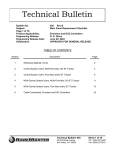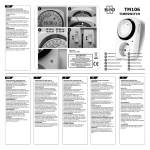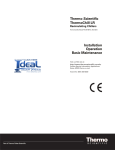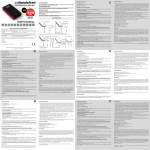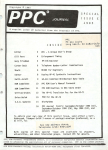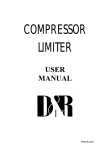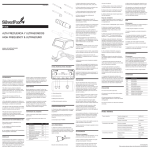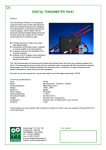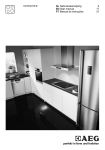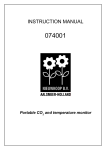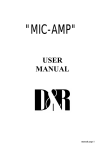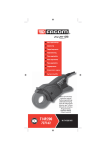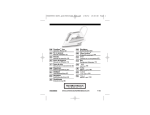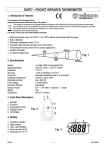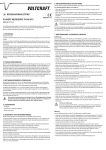Download een gebruiksaanwijzing
Transcript
GEBRUIKSAANWIJZING USER-MANUAL PH-60/65 pH / mV / °C-meter Inhoud / Content 1.0 Afbeelding / Picture.......................................................................................................... 2 2.0 Gebruiksaanwijzing / Belangrijk voor een optimale meting............................................. 2.1 Technische gegevens............................................................................................. 2.2 Onderhoud pH-elektrode ........................................................................................ 3 4 5 3.0 User-manual / Important for an accurate measurement ................................................. 3.1 Technical specifications.......................................................................................... 3.2 Maintenance pH-electrode ..................................................................................... 6 7 8 1 PH/mV/°C-meter PH-60/65 1 2 3 4 5 6 7 8 9 10 = = = = = = = = = = BNC aansluiting voor pH elektrode LCD display pH tiptoets Temperatuur tiptoets mV tiptoets Logo Temperatuur aansluiting Temperatuur instelling pH-4 afstelling pH-7 afstelling 2 1 = 2 = 3 = 4 = 5 = 6 = 7 = 8 = 9 = 10 = BNC connector for pH sensor LCD display pH button Temperature button mV button Logo Temperature connector Temperature adjustment pH-4 adjustment pH-7 adjustment 2.0 Gebruiksaanwijzing: I Door de pH-toets in te drukken stelt u het apparaat in werking, na 3 min. gaat deze automatisch uit. II pH-toets = 0.00-14.00 pH, mV = +/-1000 mV, °C = -20.0/+120.0 °C. III Druk nu op de temperatuur toets en houdt deze ingedrukt, door de draaischijf aan het instrument stelt u de temperatuur van het monster in, bij het loslaten van de temperatuur-toets schakelt deze automatisch terug op de pH-meting. IV Indien u de pH-meter, model PH-65 heeft, vervalt handeling III. III Grond, zand, veen e.d. vermengen in bijgeleverd monsterbeker "ABC" met Demi-water in de verhouding 2 delen water op 1 deel grond. (tot C met demi-water en met grond bijvullen tot streep A). Vloeistoffen kunnen direct worden gemeten. Belangrijk voor een optimale meting: I Verwijder voor de meting, de elektrode huls, deze moet altijd KCL-vloeistof bevatten. Dit voorkomt vervuiling en uitdroging. II Beweeg de elektrode voorzichtig in de te meten vloeistof. De elektrode is breekbaar, voorkom daarom stoten of contact met harde voorwerpen. III Minimaal één keer per 2 weken ijken met de bijgeleverde ijkvloeistoffen "pH-4" en "pH-7". D.m.v. bijgeleverde schroevendraaier kunt u de ijkstelschroeven aan de zijkant van het instrument instellen. Vloeistoffen zijn ± 6 maanden houdbaar mits in originele flesjes, goed afgesloten en op gelijkmatige temperatuur bewaard. IV BNC-connector uitsluitend loskoppelen bij vervanging van de elektrode. V Na de meting, elektrode schoonspoelen met Demi-water en bewaren in de KCL bewaarvloeistof. VI Wanneer "LO BATT" op het display verschijnt, dient u de batterij te vervangen. Te lage batterij spanning kan meetfouten veroorzaken. VII De pH-meter is ook leverbaar als gekombineerd instrument met EC en °C (optie: automatische ijking als continu meting/regeling. 3 2.1 Technische gegevens: Fabrikaat Meetbereik Omgevingstemperatuur Nauwkeurigheid Uitlezing pH Elektrode pH/ °C : : : : : : Voeding Meeturen Afmeting/gewicht Toebehoren : : : : Garantie meter/elektrode : Nieuwkoop Aalsmeer Holland 0,00-14,00 pH, +/- 1000 mV,-20,0/+120,0 °C 0-50 °C 0,05 pH 0,01 pH pH: Kunststof gel, 100 cm kabel met BNC-connector, °C: Pt1000 1 x batterij 9V 6F22 ± 250 uur 320x290x120 mm/ 2,1 kilo Draagkoffer, monsterbeker, opzuiger, spuitfles, alcohol thermometer (model PH60), demi- water, ijkvloeistoffen (pH-4, pH-7)schroevedraaier en KCL-bewaarvloeistof. 1 jaar/ 3 maanden 4 2.2 Gebruik en onderhoud van pH glaselektroden De pH-elektrodes behorende bij de Nieuwkoop pH-meters zijn gevuld met een verdikte elektrolyt oplossing zodat navullen niet meer nodig is. Indien toch onvoldoende elektrolyt oplossing aanwezig is, is de elektrode waarschijnlijk aan te hoge temperaturen blootgesteld en is vervanging door een andere elektrode aan te bevelen. Storingen: Worden over het algemeen veroorzaakt door: A) Afname van de gevoeligheid van het membraan. Indien dit optreedt dient de elektrode te worden gereinigd met een geschikt reinigingsmiddel. 1) Afzettingen van hydroxyden (b.v. Kalk, ijzerhydroxyde) kunnen worden verwijderd door de elektrode eerst in verdund zoutzuur te dompelen (± 5 sec.) en daarna te spoelen met demiwater. 2) Aanslag van olie en andere vetten kan het best verwijderd worden met heet water. Indien dit onvoldoende resultaat geeft kan een huishoudelijk schuurmiddel worden gebruikt zoals b.v. "Jif". 3) Eiwithoudende aanslag kan worden verwijderd met een oplossing, bevattende 8,5 ml geconcentreerd zoutzuur, 10 gr. pepsine opgelost in 1000 cc demi-water. Als voor het reinigen polaire oplosmiddelen (b.v. Aceton, Methanol) worden gebruikt is het noodzakelijk na de reiniging de elektrode enige tijd in te wateren (de gel-laag is aangetast). Als gereinigd wordt met a-polaire oplosmiddelen (b.v. Benzeen, Ether, Tolueen) is nabehandeling met een polair oplosmiddel noodzakelijk. B) Aardlek: Bij storingen dient altijd gekontroleerd te worden of de elektrodekabel in een goede staat verkeert en of de kontakten in de aansluiting en klemmen schoon en droog zijn. C) Kortsluiting door breuk of lek: De aanwijzing van de Nieuwkoop pH-meter blijft ongeveer in de buurt van de pH-7, onafhankelijk van de pH-waarde van de te meten vloeistof, indien dit optreedt moet de elektrode worden vervangen. D) Vervuiling van het diafragma: Bij gebruik in sterk verontreinigde vloeistoffen kan het diafragma snel vervuilen, waardoor een hoge overgangsweerstand over dit diafragma (glasbolletje) ontstaat. Zodra meer dan 105 ohm bedraagt treedt een (instabiele) meetfout op. De elektroden kunnen worden gereinigd met heet water (eventueel gekombineerd met een huishoudelijk afwasmiddel). Indien de vervuiling uit vetten of hydroxyden bestaat, is reiniging met een organisch oplosmiddel resp. verdund zoutzuur aan te bevelen. Ook is het mogelijk de elektrode enige tijd te plaatsen in een elektrolyt oplossing van 80oC. De elektrode moet hierin blijven tot de elektrolyt-oplossing volledig is afgekoeld. E) Vergiftiging: Een elektrode kan worden vergiftigd door het binnendringen van procesvloeistof of door diffusie van bestanddelen uit het proces medium via het diafragma. Tevens kan de binnenvloeistof met stoffen uit de proces-vloeistof een neerslag geven, waardoor het diafragma verstopt (b.v. Zilverchloride + Sulfide, neerslag van Zilversulfide). Treedt vergiftiging op dan is vervanging in de meeste gevallen noodzakelijk. Aanbevolen wordt bij niet-uitstromende elektrode bij het optreden van vergiftiging, een ander type elektrode te gebruiken. F) Slechte geleiding van de proces-vloeistof: Wanneer de elektrische geleidbaarheid van een proces-vloeistof zeer laag is, zal een instabiele fout aanwijzing optreden. Dit kan worden voorkomen door elektrolyt aan de proces-vloeistof tot te voegen. G) Veroudering van het glasmembraam: Deze veroudering uit zich in: - Afname van de reaktie snelheid - Toename van de elektrische weerstand - Afname van de gevoeligheid - Verschuiving van het nulpunt Door veroudering van de elektroden is het noodzakelijk de ijking regelmatig te herhalen. De frekwentie is afhankelijk van de gewenste nauwkeurigheid, van de processamenstelling en van de temperatuur (b.v. als de levensduur van een elektrode bij kamertemperatuur 100% bedraagt, is zij bij 80oC nog 20% en bij 120oC nog slechts 5%. 5 3.0 User manual: I To switch on the instrument press key marked "pH", after 3 min. the instrument will automatically shut off. II pH-key = 0.00-14.00 pH, mV = +/- 1000 mV, °C = -20/+120°C. III Set the temperature for the test sample by holding down the "°C" key while turning the "°C" dial on the right side to the correct temperature. The window automatically displays the pH value when the "°C" key is not pressed. IV When you have the pH-meter model PH-65, step III will be lapsed. V Soil, sand, peat and similar materials must be mixed with distilled water with a ratio of 2 parts water to 1 part soil. The C level on the sample vessel indicates 2 parts water and adding sample materials to the A level gives a ratio of 1 : 2. Water and other liquids may be measured directly. Important for an accurate measurement: I Before measurement remove the electrode cover. This cover contains KCL preservation fluid which keeps the measuring part of the electrode constantly wet. This is very important for prolonging the live of the electrode and to prevent it for drying out. II Rinse the electrode gently in the water sample. The electrode is extremely fragile and care must be taken to avoid firm impact with stones and other hard materials. III Calibration must be carried out at least one time every 2 weeks, using a fresh calibration sample (pH-4 and pH-7). These can be obtained from your dealer or from Nieuwkoop. The "pH-4"and "pH-7" set screw on the left side of the instrument is used to calibrate the pH-meter. We advise to start your calibration always with the pH-7 liquid and then pH-4. Always rinse the electrode before you go from the pH-7 into the pH-4. IV After the measurement, rinse the electrode with distilled-water and store in the KCL-liquid. V When "LO BATT" appears in the display, change the battery, low battery power may cause failures. VI The pH-meter is also available as a combination instrument with EC and °C (option: automatic calibration) or as continuous measurement/controller. 6 3.1 Technical specifications: Brand Measuring range Ambient temperature Accuracy Resolution Electrode pH/°C : : : : : : Power supply Measuring hours Dimension/weight Accessories : : : : Warranty meter/electrode : Nieuwkoop Aalsmeer Holland 0-14 pH, +/- 1000 mV, -20,0/+120,0 °C 0-50 °C 0,05 pH 0,01 pH pH: epoxy gel, 100 cm cable with BNC-connector, °C: Pt1000 1 x battery 9V 6F22 ± 250 hours 320x290x120 mm/ 2,1 kilos Carrier case, sample vessel, syringe, cleaning bottle, alcohol thermometer (model PH-60), distilled-water, calibration liquids (pH-4, pH-7), screwdriver and KCL storage liquid. 1 year/ 3 months 7 3.2 Directions for use pH-electrodes The electrodes are filled with a gelled electrolyte solution and refilling is not necessary. When there is insufficient electrolyte solution, this type of electrode has probably been used at too high temperature and therefore replacement by another type of electrode is recommended. Storage: When an electrode is to remain unused even for a small time, it is necessary to keep the glass-membrane in the KCL storage liquid in the storage reservoir. Faults: Generally, faults are caused by: A) Sensitivity decrement of the membrane. When this occurs the electrode must be cleaned with a suitable detergent. 1) Depositions of hydroxides, lime iron hydroxide can be removed by immersing the electrode in a diluted solution of hydrochloric acid and then rinsing with water. 2) Depositions of oil and fat can be removed by means of hot water together with domestic washing solution. When the result is unsatisfactory, a domestic abrasive may be carefully used. 3) Albuminous depositions can be removed by means of a solvent containing: 8,5 ml concentrated hydrochloric acid, 10 gr. pepsin and 1 ltr. demi-water. Note: When polar solvents are used for special cleaning purposes, it is necessary to soak the electrode for some time after cleaning as the polar solvent influences the gel layer. When an a-polar solvent is used (benzene, ether, toluene) after treatment with a polar solvent (methanol, acetone) is necessary. B) Leakage to earth: Fault indications can be expected when the resistance between reference system and screening falls below 10/7 Ohm. When a fault occurs, first check if the electrode cable is in good condition and if the connector contacts and the terminals in the Nieuwkoop pHmeter or connection box are clean and dry. C) Short circuit by break or leakage: The pH-meter reading remains about pH-7 and is not dependant on the pH-value of the liquid being measured. If this occurs, the electrode should be replaced. D) Diaphragm poisoning: Strongly polluted liquids can cause the diaphragm to foul very quickly. As a result, there will be a transition resistance over the diaphragm. When this resistance exceeds 10/5 Ohm instability of reading and incorrect indication of the measured value will occur. Fouled electrodes can be cleaned with hot water together with a domestic washing solution if necessary. When fouling is caused by fat or hydroxides (lime) cleaning with an organic solvent or diluted acid respectively is recommended. It may be necessary with this nonflow electrode of the Nieuwkoop pH-meter, to place the electrode for a period in an electrolyte solution at 80 oC and let them remain until the solution has completely cooled. E) Poisoning: An electrode can be poisoned by the penetration of the process liquid or by diffusion of components of the process medium through the diaphragm. In addition, the inner liquid in combination with the dust from the process medium may give deposits which block the diaphragm (e.g. silver chloride + sulphide, deposits of silver sulphide. When poisoning occurs replacement of the electrode will normally be necessary. It is recommended if poisoning of a non-flow electrode occurs to use an alternate type of electrode. F) Poor conduction of the process liquid: When the electrical conduction of a process liquid is very low, an instability of reading will occur. This problem may be cured either by adding electrolyte solution to the process liquid or, if this is not possible, by making the reference input of the measuring instrument high impedance. G) Degrading of the glass membrane: Degrading has one of the following effects: -Decrease of the speed of response -increase of the electrical resistance -decrease of the sensitivity -zero point shift. The effect of ageing of the electrodes makes it necessary to carry out the re-calibration of the electrode system regularly. The frequency depends on the required accuracy, the composition of the sample to be measured and the temperature. E.g. if the lifetime of an electrode is 100% at the room temperature it will be 20% at 80 oC and only 5% at 120 oC. It is possible to reactive an aged electrode by immersing for 10 seconds in a PVC beaker containing a solution of vinegar (1 mol.) and potassium fluoride (1 mol.) Ratio 1:1. After this the electrode must be cleaned carefully. Warning: As a result of a strong etching proportion of the acid, the handling should be done carefully and in consultation with a safety officer. See further instructions of the pH-meter or combined pH/EC-meter. 8 Uw leverancier/Your supplier: Aalsmeerderweg 249s, 1432 CM Postbus 78, 1430 AB AALSMEER - HOLLAND Tel. +31 (0)297 325836 Fax +31 (0)297 323167 E-mail: [email protected] Internet: www.nieuwkoopbv.nl 9










